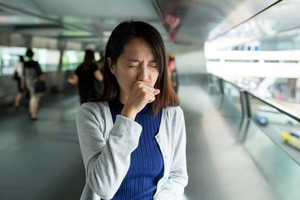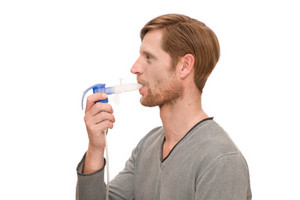
Coughing fits are a nuisance and a strain. If you get a coughing fit in public, it can often be awkward, too. Very frequent and persistent coughing fits can also put a strain on the tissue of the lungs. But what can you do against a coughing fit?
These eight tips can help you get the urge to cough under control and can prevent or at least lessen coughing fits. And you can combine these tricks with each other if you are often plagued by coughing fits.

You should keep your mucosal membranes moist. This makes them less likely to be irritated. This means you should always drink enough to keep the mucosal membranes in your mouth and throat moist.
Drinking also helps fight off an urgent urge to cough. Take a sip as soon as you notice that you are going to need to cough. Ideally you should drink still water (not too cold), lukewarm herbal tea or other non-fizzy drinks. This usually quells the urge to cough.
Sweets and chewing gum stimulate the flow of saliva, which in turn keeps your throat moist. If you feel you need to cough because your throat is tickly, this tip definitely helps.
If you can feel that you need to cough, breathe or cough with pursed lips or through your fist. These two breathing techniques are known as stenosis breathing – i.e. breathing against resistance. This slows the speed of the exhaled air right down. It also protects the bronchial tubes from collapsing.
» you can also use the PARI PEP systems for stenosis breathing
What if your urge to cough is already past the point of no return? Then cough against your fist, the back of your hand or a tissue held directly over your mouth. This makes it easier to cough and means that the coughing fit does not last as long.
You can also prevent coughing fits by holding your breath as soon as you get the urge to cough and resisting the pressure building up in your lungs. Hold your breath for as long as you can and do not breathe. Then take short shallow breaths after you have held your breath. After this conscious shallow breathing, hold your breath again.
Repeat this pattern as many times as you need to. If you have the feeling that you no longer need to cough, carefully take a deep breath in and out. This helps you test if your airways are stabilised again. If not, repeat the conscious shallow breathing.
In certain situations or physical conditions, a cough may come on quicker than usual. Usually this happens if your airways are already or are becoming irritated (if you have an infection, for example).
Try to avoid situations or circumstances, such as:
Be vigilant and reflect when and what makes you more likely to cough or triggers an urge to cough in you. Where possible, avoid this specific trigger that makes you want to cough.

If you get a coughing fit while you are doing your breathing physiotherapy, you can use a breathing aid as you breathe out, such as the PARI PEP systems. This helps you breathe out against resistance so that your lungs do not collapse or become restricted. Congested bronchial tubes can trigger a cough.
Do you find that you cough more in winter (central heating) or after situations where you are exposed to air pollution (such as Sahara dust in the air, exhaust fumes or dusting)? In that case, inhalation therapy with a nebuliser can help you moisten your lungs and release the dirt particles trapped in the mucus. Often mucus triggers a coughing fit because it blocks or constricts the bronchial tubes.
If you consistently have coughing fits, you are strongly advised to go to the doctor so they can get to the bottom of what is making you cough. The GP or pulmonary practice will generally prescribe a suitable respiratory therapy.
This article was written in cooperation with the experienced physiotherapist and respiratory therapist Rita Kieselmann, who has been working in this field since 1974. Her focus is on the treatment of children and adults with chronic respiratory diseases.
Rita Kieselmann is the founder of the Physiotherapy working group in the Mukoviszidose e. V. (Cystic Fibrosis Association in Germany). She has also developed self-help techniques for clearing mucus such as modified autogenic drainage and others.
An article written by the PARI BLOG editorial team.
© 2025 PARI GmbH Spezialisten für effektive Inhalation